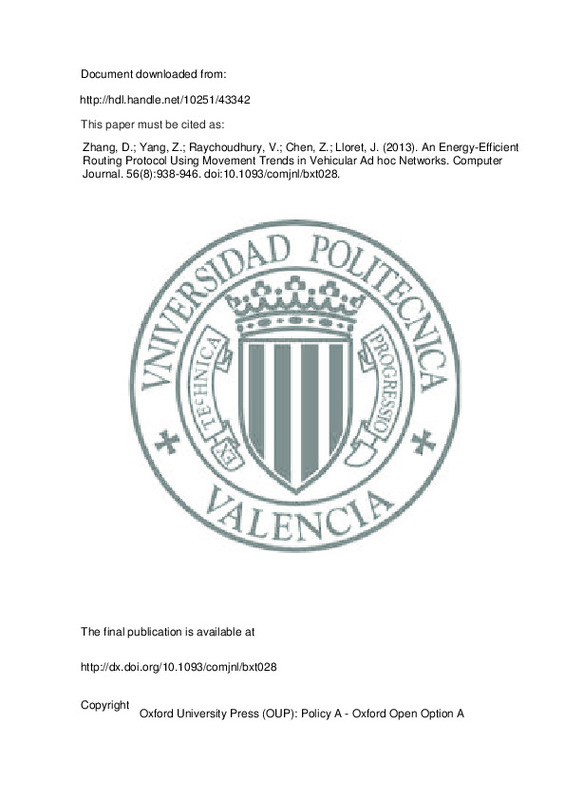JavaScript is disabled for your browser. Some features of this site may not work without it.
Buscar en RiuNet
Listar
Mi cuenta
Estadísticas
Ayuda RiuNet
Admin. UPV
An Energy-Efficient Routing Protocol Using Movement Trends in Vehicular Ad hoc Networks
Mostrar el registro sencillo del ítem
Ficheros en el ítem
| dc.contributor.author | Zhang, Daqiang
|
es_ES |
| dc.contributor.author | Yang, Zhijun
|
es_ES |
| dc.contributor.author | Raychoudhury, Vaskar
|
es_ES |
| dc.contributor.author | Chen, Zhe
|
es_ES |
| dc.contributor.author | Lloret, Jaime
|
es_ES |
| dc.date.accessioned | 2014-10-16T14:13:33Z | |
| dc.date.available | 2014-10-16T14:13:33Z | |
| dc.date.issued | 2013-08 | |
| dc.identifier.issn | 0010-4620 | |
| dc.identifier.uri | http://hdl.handle.net/10251/43342 | |
| dc.description | This is a pre-copyedited, author-produced PDF of an article accepted for publication in Computer Journal following peer review. The definitive publisher-authenticated version "Daqiang; Zhijun; Vaskar; Zhe; Lloret, J. (2013). An Energy-Efficient Routing Protocol Using Movement Trends in Vehicular Ad hoc Networks. Computer Journal. 56(8):938-946. doi:10.1093/comjnl/bxt028." is available online at: http://comjnl.oxfordjournals.org/ | es_ES |
| dc.description.abstract | Vehicular Ad hoc Networks (VANETs) are a killer application of Mobile Ad hoc Networks (MANETs), which exchange data among vehicles and vehicles to roadside infrastructures by routing. To save energy, various routing protocols for VANETs have been proposed in recent years. However, VANETs impose challenging issues to routing. These issues consist of dynamical road topology, various road obstacles, high vehicle movement and the fact that the vehicle movement is constrained on roads and traffic conditions. Moreover, the movement is significantly influenced by driving behaviors and vehicle categories. To this end, we incorporate them into routing and propose energy-efficient routing using movement trends (ERBA) for VANETs-an energy-efficient routing protocol. ERBA classifies vehicles into several categories, and then leverages vehicle movement trends to make routing recommendation. It predicts the movement trends by current directions and next directions after going through the road intersections. With the vehicular category information, the driving behavior patterns, the distance between the current sections and the next intersections, ERBA propagates information among vehicles with less energy consumption. The proposed scheme is validated by real urban scenarios extracted from ShanghaiGrid project. Experimental results show that ERBA outperforms the compared routing protocols with respect to the end-end delay, the packet delivery ratio and the path duration time. | es_ES |
| dc.description.sponsorship | This work was supported by the National Natural Science Foundation of China (Grant Nos. 61103185, 61100034, 61003247 and 61073118), the Start-up Foundation of Nanjing Normal University (Grant No. 2011119XGQ0072) and Natural Science Foundation of the Higher Education Institutions of Jiangsu Province, China (Grant No. 11KJB520009). This work is also supported by Major Program of National Natural Science Foundation of Jiangsu Province (Grant No. BK2011005). | en_EN |
| dc.language | Inglés | es_ES |
| dc.publisher | Oxford University Press (OUP): Policy A - Oxford Open Option A | es_ES |
| dc.relation.ispartof | Computer Journal | es_ES |
| dc.rights | Reserva de todos los derechos | es_ES |
| dc.subject | movement trends | es_ES |
| dc.subject | vehicular ad hoc networks | es_ES |
| dc.subject | VANETs | es_ES |
| dc.subject | energy-efficient | es_ES |
| dc.subject.classification | INGENIERIA TELEMATICA | es_ES |
| dc.title | An Energy-Efficient Routing Protocol Using Movement Trends in Vehicular Ad hoc Networks | es_ES |
| dc.type | Artículo | es_ES |
| dc.identifier.doi | 10.1093/comjnl/bxt028 | |
| dc.relation.projectID | info:eu-repo/grantAgreement/NSFC//61100034/ | es_ES |
| dc.relation.projectID | info:eu-repo/grantAgreement/NSFC//61103185/ | es_ES |
| dc.relation.projectID | info:eu-repo/grantAgreement/NNU//2011119XGQ0072/ | es_ES |
| dc.relation.projectID | info:eu-repo/grantAgreement/NSFC//61073118/ | es_ES |
| dc.relation.projectID | info:eu-repo/grantAgreement/Natural Science Research of Jiangsu Higher Education Institutions of China//11KJB520009/ | es_ES |
| dc.relation.projectID | info:eu-repo/grantAgreement/NSFC//61003247/ | es_ES |
| dc.rights.accessRights | Abierto | es_ES |
| dc.contributor.affiliation | Universitat Politècnica de València. Departamento de Comunicaciones - Departament de Comunicacions | es_ES |
| dc.contributor.affiliation | Universitat Politècnica de València. Instituto de Investigación para la Gestión Integral de Zonas Costeras - Institut d'Investigació per a la Gestió Integral de Zones Costaneres | es_ES |
| dc.description.bibliographicCitation | Zhang, D.; Yang, Z.; Raychoudhury, V.; Chen, Z.; Lloret, J. (2013). An Energy-Efficient Routing Protocol Using Movement Trends in Vehicular Ad hoc Networks. Computer Journal. 56(8):938-946. https://doi.org/10.1093/comjnl/bxt028 | es_ES |
| dc.description.accrualMethod | S | es_ES |
| dc.relation.publisherversion | http://dx.doi.org/10.1093/comjnl/bxt028 | es_ES |
| dc.description.upvformatpinicio | 938 | es_ES |
| dc.description.upvformatpfin | 946 | es_ES |
| dc.type.version | info:eu-repo/semantics/publishedVersion | es_ES |
| dc.description.volume | 56 | es_ES |
| dc.description.issue | 8 | es_ES |
| dc.relation.senia | 265792 | |
| dc.contributor.funder | Natural Science Research of Jiangsu Higher Education Institutions of China | es_ES |
| dc.contributor.funder | National Natural Science Foundation of China | es_ES |
| dc.contributor.funder | Nanjing Normal University | es_ES |
| dc.contributor.funder | Natural Science Foundation of Jiangsu Province | es_ES |







![[Cerrado]](/themes/UPV/images/candado.png)

